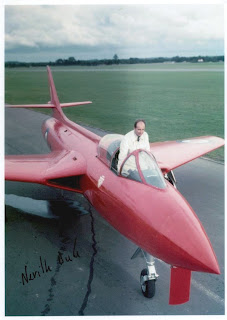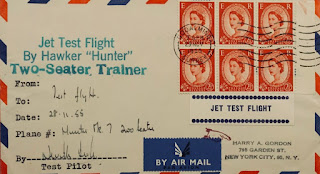He was then sent to the Middle East for what was to be a six weeks' detachment, but which, in the end, lasted to near the end of the War. Flying Spitfires, Tomahawks and Kittyhawks on Nos. 112 and 92 Squadrons in the Western Desert and commanding No. 145 Squadron in Italy, he became the top scoring Allied pilot in the Theatre credited with the destruction of 28 enemy aircraft confirmed, 3 probably destroyed, plus 5 damaged. In these three years, he was awarded the DSO and the DFC with two bars.
At the end of the War, he was 23 years old. In 1945, he was posted to Hawkers as an RAF test pilot, graduated from No 4 ETPS course in 1946 and then joined the RAF High Speed Flight, which gained the world speed record in 1946 in a Meteor 4. He completed two years as a Squadron Leader at A&AEE Boscombe Down, being awarded an AFC in 1948, before being invited to become a civilian test pilot with Hawker Aircraft, then at Langley. There, he test flew production Furies and Tempests and also the first Hawker jet aircraft, the prototype P1040. During this period he established world records on Fury delivery flights to the Pakistan and Egyptian Air Forces - from London to Rome (1949), London to Karachi (1949), and London to Cairo (1950). He was the owner of a Hawker Tomtit, now in the Shuttleworth Collection, which he flew regularly at air displays. He also joined the Royal Auxiliary Air Force, becoming Commanding Officer of No 615 (County of Surrey) Squadron at Biggin Hill, equipped with Spitfire Mk 22s and later Meteor 4s and having Winston Churchill as its Honorary Air Commodore. He held the post of Chief Test Pilot at Hawkers from 1951 to 1956.
His name will always be linked with the test flying of Sydney Camm's P1067, which became the Hunter. He flew its first flight on 20 July 1951 from Boscombe Down in WB 188 (becoming, almost certainly, the first pilot to wear a Bonedome in a British aircraft) and led the test flying programme of the RAF's first aircraft capable of exceeding the speed of sound. In it, he planted the first sonic boom for all to hear across Southern England in a shallow dive from 30,000ft on 24 June 1952. The following year, again in WB 188, this time modified with addition of reheat, he set a low altitude world speed record of 727.6mph, averaged over three runs, flying a course off the South Coast near Tangmere on 7 September 1953. Neville Duke was awarded the OBE in 1953 and the next year was the recipient of the Gold Medal of the Royal Aero Club and the Segrave Trophy. Additionally, he was awarded the Gold Medal of the Royal Danish Aero Club in 1953, two De La Vaux FAI Medals in 1954,and a Queen's Commendation in 1955. In 2002, he was recipient of the Air League's Geoffrey Quill Medal.







 Neville Duke joined the Royal Air Force in 1940 at the age of 18 as an AC2 pilot-under-training. After learning to fly at No. 13 Elementary Flying Training School, White Waltham, he received his wings in February 1941. Newly commissioned, he converted to the Spitfire at No.58 OTU, Grangemouth, and joined No. 92 Fighter Squadron at Biggin Hill in 1941, his first "Kill" being a Messerschmitt Bfl09 over Dunkirk.
Neville Duke joined the Royal Air Force in 1940 at the age of 18 as an AC2 pilot-under-training. After learning to fly at No. 13 Elementary Flying Training School, White Waltham, he received his wings in February 1941. Newly commissioned, he converted to the Spitfire at No.58 OTU, Grangemouth, and joined No. 92 Fighter Squadron at Biggin Hill in 1941, his first "Kill" being a Messerschmitt Bfl09 over Dunkirk. 




<< Home